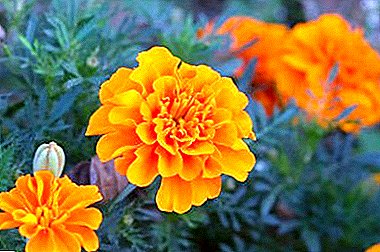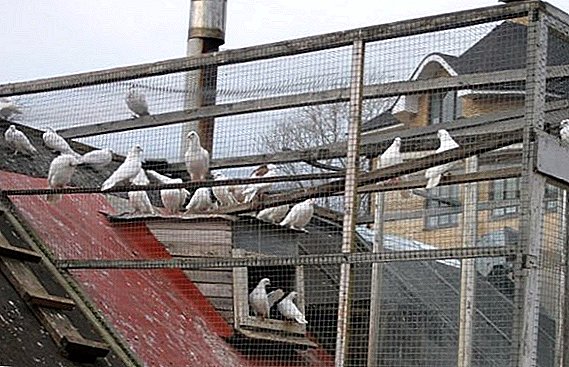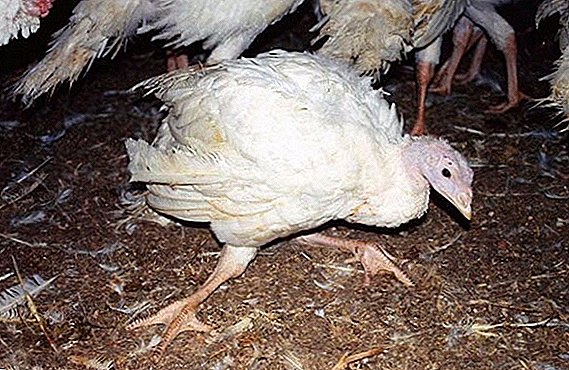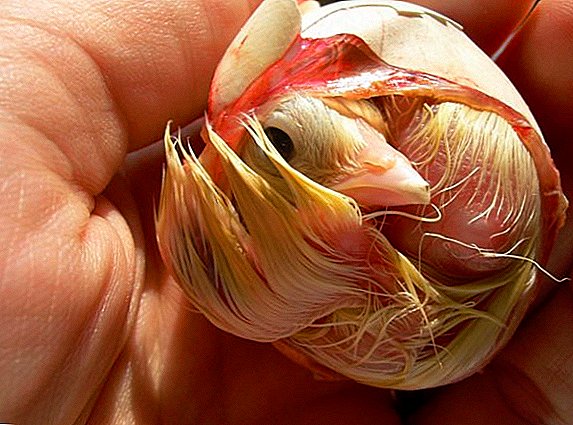
Marigolds, or as they are called, Chernobrivtsy are common flowers in summer cottages and in front gardens.
These plants bloom in early summer, and beautiful, bright inflorescences hold up to the first frost, decorating the garden.
When exactly expect the flowering of marigolds, how it happens and how to speed it up - our article will tell you about it.
What is this plant?
Marigolds are a genus of perennial and annual plants. They look like bushes with a height from 20 to 120 cm, with erect branched stems and pinnate toothed leaves. The color of greens can be from light to dark green.
There are three types of marigolds:
- erect;
- rejected;
- thin-leaved.
Learn how to grow upright Erect, Thin-leaved, Rejected species of marigolds in open ground, as well as get acquainted with the photo of flowers here.
 Due to the high content of essential oils, all marigolds have a peculiar spicy smell. Because of this, they can be used for food - as a seasoning (details about the use of marigolds in traditional medicine and cooking can be found here). Marigolds belong to the Aster family. They have the official name used in the international classification: Tagetes (Tagetes). This name was given thanks to Greek mythology, in which there was a god Tages, handsome, able to predict the future.
Due to the high content of essential oils, all marigolds have a peculiar spicy smell. Because of this, they can be used for food - as a seasoning (details about the use of marigolds in traditional medicine and cooking can be found here). Marigolds belong to the Aster family. They have the official name used in the international classification: Tagetes (Tagetes). This name was given thanks to Greek mythology, in which there was a god Tages, handsome, able to predict the future.
According to legend, he was the grandson of Jupiter himself, which is why the flowers named after him are so beautiful and bring happiness. In Europe, marigolds came from Mexico, and gardeners quickly became fond of.
Flowering features
When marigolds bloom? The estimated period of flowering marigold - 2 - 2.5 months after germination. That is, approximately from the middle of June. With proper care, they will decorate the garden until winter. These flowers are not afraid of drought, but the first frost will make their petals fly around.
Buds lush and very bright, resembling a ball, with very hard petals. The flowers have wide corollas, allowing to accurately distinguish marigolds from other plants. The color of the buds varies: these are all shades of yellow, orange, red and brown. Buds open gradually, replacing each other. At the same time, withering flowers are inside the bush, while young flowers and not yet opened buds are on the periphery, which gives the plant a neat appearance throughout the season.
Juicy colors allow you to use the plant in flowerbeds. Also, varieties with long stems can be grown for cutting: marigolds stand in a vase for up to 14 days.
The variety of thin-leaved marigolds blooms most abundantly.
A photo
The photo below shows how marigold flowers look like:





The necessary conditions
Marigold rather unpretentious in terms of watering. They can safely be planted in the country, and only occasionally come to water - they are able to withstand a week or even two without watering. But with the choice of a landing site, not everything is so simple.
These flowers are drawn to the sun: the marigolds will be most abundant in the sun, and not in partial shade. On a plant planted in the shade, there may be no flowers at all, or the whole pair will be tied, while its neighbor will quietly bloom in the open sun.
If there is no opportunity to plant marigolds in the open, it is possible to choose partial shade, but only on the condition that direct sunlight hits the plant for at least a couple of hours a day.
Another prerequisite for flowering is dry soil. The fact is that the marigolds have fallen into our climate from hot countries, and as a result, they do not tolerate dampness and marshiness of the soil. Near the open source of water - a fountain, a stream or a reservoir - marigolds will not bloom. Moreover, excessive moisture will lead to dangerous diseases for the plant: black leg, root or gray rot. There is no cure for these diseases, the affected flowers will have to be plucked or burned.
All of the above does not mean that making marigolds flourish, if the area is wet and damp, is quite impossible.
You can resort to such tricks:
- Make a high bed with drainage. To do this, the soil rises, and crushed stone, stones or broken bricks are poured at the base.
- Dig through the rainwater grooves - advice is relevant if it rains frequently in your area. You can even grow marigolds under a canopy (but do not forget to shoot it on sunny days).
- Plant marigolds in a large decorative pot, in which dampness can not touch the plant.
Proper care
 Caring for marigolds is not burdensome.
Caring for marigolds is not burdensome.
Enough:
- Provide regular access to sunlight.
- Water occasionally, reducing watering at the time of flowering to a minimum, while not allowing overflow and stagnation of water in the holes.
- Loosen the soil around the plant (once a week) so that it can breathe.
- Prevent the emergence of weeds around the marigolds. Argued that marigolds themselves are able to destroy the weeds. This is true, but with a large influx of pests the plant cannot cope - it can stop blooming and lose its attractive appearance.
- How much to feed? Fertilize at least three times: after the shoots reach a size of 10 cm, with the ovary of the first buds and during their opening.
- Remove old inflorescences so that they do not interfere with the appearance of new ones, periodically trim the bush.
- If the weather is rainy, it is worthwhile to place a small container with bleach on the flower bed with marigolds. It will scare off snails and slugs that are capable of causing significant damage to this plant.
Why not please flowers?
Despite the fact that usually marigolds bloom in June, sometimes it happens that June ends, then July, and there are still no inflorescences. The most common reason for this is lack of sunlight, but there may be another.
First you need to find out how the marigolds were grown: seedlings or sowing directly into the ground. Seedlings really bloom in June, but only if they were picked on time. Otherwise, when landing in the ground, the roots will be damaged, and the marigolds will have to “come to their senses” for a long time, building up roots and getting used to the new conditions. It will take time in which the buds could be tied.
Sowing directly into the ground, in turn, is timed to care for the night frost - marigolds do not tolerate temperatures even at 0 degrees. If it is still cool by the end of May, then the seeds should be sown not earlier than 15 (read about the nuances of growing marigolds from seeds here, and from this article you will learn how to collect marigold seeds to avoid buying them). They will ascend only by the end of the month and, therefore, will not bloom before the end of July. And if the entrances are still thick, and they have to be seated, the flowering will be transferred to the beginning of August.
 The lack of flowering may also depend on the variety: rejected marigolds bloom before all, and thin-leaved later. Dates of flowering will be indicated on a bag of seeds. So sometimes you just have to wait and bloom.
The lack of flowering may also depend on the variety: rejected marigolds bloom before all, and thin-leaved later. Dates of flowering will be indicated on a bag of seeds. So sometimes you just have to wait and bloom.
Sometimes the marigolds stop blooming because of the intense heat: in this case the leaves will wilt during the day and come to life in the evening. With constant drought, a spider mite can attack the plant. To avoid this and resume flowering, marigold need to be sprayed twice a day.
Also, the problem may be in excess or lack of nutrients. With an excess of nitrogen, flowers all the forces spend on building leaves, and buds do not have time to form. At the same time, with a lack of nutrients such as phosphorus and potassium, there will be no flowering.
How to make dissolve the buds?
The best way to achieve abundant and long flowering of marigolds is to properly care for them. and protect them from all the above troubles. To get a beautiful flowerbed of these plants in early June, you need:
- Grow marigolds from seedlings, with obligatory picks.
- Cover the seedlings until the night chill is complete.
- To build drainage for the soil.
- Provide access to the sun. Marigolds tolerate transplantation well, so that if the plant does not bloom in a shady area, it can simply be transplanted.
- Inspect flowers frequently to detect pests or diseases in time.
- In the heat spray plants.
- Choose for planting early varieties.
An excellent incentive to bloom will be top dressing. But you need to do it correctly:
- Fertilize the plants necessarily "not dry" - 2 hours before feeding the flower bed must be watered to avoid burning the roots.
- For the first time, marigolds are fed 2 weeks after landing in the ground, with nitrogen fertilizer: 1 tbsp. urea in a bucket of water.
- The second time - 2-3 weeks after nitrogen feeding and the third - after the formation of the first bud - marigolds are fed with superphosphate and potassium sulfate, at the rate of 1 tbsp. on the bucket.
Conclusion
Now you know how to properly care for marigolds. The most important thing is timely disembarkation, dry soil and bright sunlight, and if the soil is poor, it is also top dressing. If these conditions are met, the plant will not hesitate with flowering and will delight you with many lush sunny buds!












